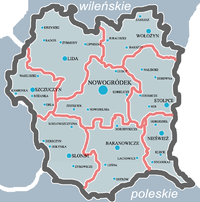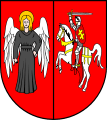Nowogródek Voivodeship (1919–39)
| Nowogródek Voivodeship Województwo nowogródzkie | |||||
| Voivodeship of Poland | |||||
| |||||
|
Coat of arms | |||||
 | |||||
| Capital | Nowogródek | ||||
| Government | Voivodeship | ||||
| Voivodes | |||||
| • | Jun-Oct 1921 | Czesław Krupski | |||
| • | 1935-1939 | Adam Korwin-Sokołowski | |||
| Historical era | Interwar period | ||||
| • | Established | 14 February 1921 | |||
| • | Invasion | 17 September 1939 | |||
| • | Voting and annexation | October–November 1939 | |||
| Area | |||||
| • | 1939 | 22,966 km2 (8,867 sq mi) | |||
| Population | |||||
| • | 1921 | 822,106 | |||
| • | 1931 | 1,057,000 | |||
| Political subdivisions | 8 powiats and 8 cities | ||||
| Today part of | Belarus, Lithuania | ||||
Nowogródek Voivodeship (Polish: Województwo nowogródzkie) was a unit of administrative division of the Second Polish Republic between 1919 and 1939, with the capital in Nowogródek (now Navahrudak, Belarus). Following German and Soviet Invasion of Poland of September 1939, Poland's borders were redrawn in accordance with the Molotov–Ribbentrop Pact. The Nowogródek Voivodeship was incorporated into the Belarusian Soviet Socialist Republic following staged elections. With the end of World War II, at the insistence of Joseph Stalin at the Tehran Conference of 1943, the area remained in Soviet hands, and the Polish population was soon forcibly resettled. Since 1991, most part of it belongs to the sovereign Republic of Belarus.[1]
Location and area
The voivodeship covered 22,966 square kilometers. It was located in north-eastern part of the country, bordering Soviet Union to the east, Białystok Voivodeship to the west, Polesie Voivodeship to the south and Wilno Voivodeship to the north. The landscape was flat and heavily wooded, lying within the Neman River basin.
Population
Nowogródek Voivodeship consisted of 8 cities, 8 powiats (districts) subdivided further into futory and kolonie, and 89 villages. The Polish census of 1921 data reveals that the voivodeship was inhabited by 800,761 people, and the population density was 35.3 persons per km2. A decade later, the Polish census of 1931 results showed a steady increase in population at 1,057,200 inhabitants, of whom 82% were engaged in agricultural activities.[2] In 1921, 55% of persons over the age of 10 were illiterate due to repressive policies of the Russian Empire. In the reborn Polish Republic, the number of public schools greatly increased, and the illiteracy dropped to 35% by 1931.[3]
The Polish government conducted two official surveys 10 years apart in order to determine the economic and minority status of the country. Both censuses asked respondents for their religious affiliations. The ethnic composition findings have been disputed especially after World War II. The 1921 census in accordance with guidelines of the 1918 League of Nations Minority Treaties, asked about nationality prompting many respondents of different ethnic backgrounds living in Poland, to declare Polish by default.[1] The 1931 census substituted this question with a more specific one regarding the respondents' "mother tongue" which in turn, prompted many respondents to simply call it "local".[4]
According to the published and official results of 1931 Polish census,[5] of the 1,057,147 inhabitants of the Nowogródek Voivodeship, 553,859 spoke Polish, 413,466 spoke Belorussian, 69,782 spoke Yiddish, 7,243 spoke Hebrew, 6,794 spoke Russian, and 2,499 spoke Lithuanian. The remainder spoke Ukrainian, Rusyn, German, Czech and others.[5] In percentage points this translates into an estimate of 53% of the population who identified their mother tongue as Polish, 39% as Belorussian, 7% as Yiddish and 1% as Russian.[6][7] According to assessment by Tadeusz Piotrowski (1998) the census recorded the number of Poles as greater only because the language spoken wasn't defined unambiguosly, thus quoting figures adjusted by Jerzy Tomaszewski (1985) as follows: the Nowogródek Voivodeship was home to about 616,000 ethnic Belorussians, or 38% of the total population of Polish lands later annexed by Stalin. The number of ethnic Belorussians (including tutejsi) exceeded the number of ethnic Poles by eight percentage points according to him.[8] Similarly, the Jewish population statistics were allegedly reduced by about 4% in the actual number of dependants. The chairman of the Polish census statistical office, Edward Szturm de Sztrem stated after World War II that the returned forms might have been tampered with by the executive power, but to what extent is not known.[9][10] Jerzy Tomaszewski categorizes the largest non-Polish component as Belarusian and Ukrainian at 58.37% combined; and 7.85% as Jewish (as quoted by Teichova & Matis).[2]
Cities and counties
The historical town of Nowogródek was the smallest of all voivodeship’s capitals in Poland, with population of almost 10,000 (as of 1939). The area’s largest city was the key railroad junction of Baranowicze, which grew quickly during the 1930s. Its 1931 population was almost 23,000. Other important centers of the voivodeship were Lida (in 1931 pop. 20,000), Słonim (pop. 16,000), and Nieśwież (pop. 8,000).
The division of Nowogródek voivodeship till 1929 was given in below. It was also included countries of Duniłowicze, Dzisna (whose center was Głębokie) and Wilejka between 1921 and 1922 till they were passed to Wilno Land.
| List of Counties with square area and population | ||||
|---|---|---|---|---|
| # | Name | CoA | Area | Population |
| 1 | Baranowicze county | |
3,298 km² | 161,100 |
| 2 | Lida county | |
4,258 km² | 183,500 |
| 3 | Nieśwież county | |
1,968 km² | 114,500 |
| 4 | Nowogródek county | |
2,930 km² | 149,500 |
| 5 | Słonim county | |
3,069 km² | 126,500 |
| 6 | Stołpce county | |
2,371 km² | 99,400 |
| 7 | Szczuczyn county | |
2,273 km² | 107,200 |
| 8 | Wołożyn county | |
2,799 km² | 115,500 |
Country of Szczuczyn was created from gmina of Kamionka in of Grodno County in Bialystok voivodeship and gminas of Dziembrów, Lebioda, Nowy Dwór, Orla, Ostryna, Różanka, Sobakińce, Szczuczyn, Wasiliszki and Żołudek in Lida County on 21 March 1929.[11]
Railroads and industry
Nowogródek Voivodeship was located in the so-called Poland “B”, which meant that it was underdeveloped, with industry insufficient to improve livability. Large part of population was poor, with the lingering high level of illiteracy and low level of agricultural production. Railroad network was scarce (total length was only 713 kilometers, or 3.1 per 100 km²), with only two junctions - at Baranowicze and Lida. Nowogródek itself was not located on any main rail connections, it was reachable only by narrow-gauge track.
Voivodes

- Czesław Krupski June 1921 – 17 October 1921 (acting)
- Władysław Raczkiewicz 17 October 1921 – 29 August 1924
- Marian Żegota-Januszajtis 29 August 1924 – 24 August 1926
- Vacant 24 August 1926 – 24 September 1926
- Zygmunt Beczkowicz 24 September 1926 – 20 June 1931
- Wacław Kostek-Biernacki 1 July 1931 – 8 September 1932
- Stefan Świderski 8 September 1932 – 2 December 1935 (acting to 1933)
- Adam Korwin-Sokołowski 17 December 1935 – 17 September 1939
September 1939 and its aftermath
On September 17, 1939, following German aggression on Poland and Molotov-Ribbentrop Pact, Soviet forces invaded eastern Poland. As bulk of Polish Army was concentrated in the west, fighting Germans, the Soviets met with little resistance and their troops quickly moved westwards, occupying Voivodeship’s area with ease.
After the Polish Defensive War of 1939 the area was occupied by the Soviet Union, and then (after 1941) by Germany. After World War II the area was annexed by the Soviet union, and most was incorporated into the Byelorussian SSR. The northern part of the former Lida county, including the town of Ejszyszki (Lith. Eisiskes) became part of Lithuania.[1]
Notes and references
- 1 2 3 Piotr Eberhardt; Jan Owsinski (2003). Ethnic Groups and Population Changes in Twentieth-century Central-Eastern Europe: History, Data, Analysis. M.E. Sharpe. pp. 199–201. ISBN 978-0-7656-0665-5.
- 1 2 Alice Teichova, Herbert Matis, Jaroslav Pátek (2000). Economic Change and the National Question in Twentieth-century Europe. Cambridge University Press. ISBN 978-0-521-63037-5.
- ↑ Peter F Simple; Peter F. Sugar; Joseph Rothschild; Donald Warren Treadgold (1975). East Central Europe Between the Two World Wars. University of Washington Press. ISBN 978-0-295-95357-1.
- ↑ Celia Stopnicka Heller (1993). On the Edge of Destruction: Jews of Poland Between the Two World Wars. Wayne State University Press. ISBN 978-0-8143-2494-3.
- 1 2 Statistical Office (Poland) Główny Urząd Statystyczny (Central Statistical Office (Poland). "Ludność według płci i wyznania". Wikimedia Commons: Woj.nowogrodzkie-Polska spis powszechny 1931, p. 50 / 270 in PDF or 19 in document.
- ↑ Radziwiłł A. & Roszkowski W. (2001). Historia 1871-1939. Podręcznik dla szkół średnich [History 1871-1939. Textbook for Secondary Schools]. Warszawa: Wydawnictwo Szkolne PWN. Length 363 pages. ISBN 83-7195-050-0.
Citing General Census in 1931.
- ↑ Main Statistical Office of Poland (June 1939), Maly Rocznik Statystyczny 1939, Warsaw, page 23.
- ↑ Tadeusz Piotrowski (1998). Poland's Holocaust. McFarland. pp. 143, 353. ISBN 0786403713.
The number of Belorussians in the Republic, according to Tomaszewski, were distributed as follows: Polesie, 654,000; Nowogrodek, 616,000; Wilno, 409,000; and Bialystok, 269,100.
- ↑ Joseph Marcus (1993). Social and Political History of the Jews in Poland, 1919-1939. Walter de Gruyter. ISBN 978-90-279-3239-6.
- ↑ Richard Blanke (1993). Orphans of Versailles: The Germans in Western Poland, 1918-1939. University Press of Kentucky. ISBN 978-0-8131-1803-1.
- ↑ http://isap.sejm.gov.pl/DetailsServlet?id=WDU19290330307
- Maly rocznik statystyczny 1939, Nakladem Glownego Urzedu Statystycznego, Warszawa 1939 (Concise Statistical Year-Book of Poland, Warsaw 1939).
See also
- Belarus’ current Hrodna Voblast
- Defiance (2008 film)
- Tuvia Bielski
- Witold Pilecki
- Adolf Pilch
- Nowogródek Voivodeship (1507–1795)
Coordinates: 53°00′N 25°00′E / 53.000°N 25.000°E

